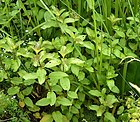Note: This is a project under development. The articles on this wiki are just being initiated and broadly incomplete. You can Help creating new pages.
Mentha aquatica
Mentha aquatica (water mint; syn. Mentha hirsuta Huds.) is a perennial flowering plant in the mint family Lamiaceae. It grows in moist places and is native to much of Europe, northwest Africa and southwest Asia.
Uses
Anodyne, Antiseptic, Antispasmodic, Astringent, Carminative, Cholagogue, Diaphoretic, Emetic, Refrigerant.
Parts Used
Chemical Composition
The main substances identified were: menthofuran (51.26 to 58.59%), limonene (5.94 to 12.06%), trans-β-ocimene (5.59 to 6.10%), ledol (3.01 to 4.06%) and β- caryophyllene (2.923 to 3.557%). Key words: Mentha aquatica, phenophases, essential oil, menthofuran.[1]
Common names
| Language | Common name |
|---|---|
| Kannada | |
| Hindi | |
| Malayalam | |
| Tamil | |
| Telugu | |
| Marathi | NA |
| Gujarathi | NA |
| Punjabi | NA |
| Kashmiri | NA |
| Sanskrit | |
| English | Water Mint |
Properties
Reference: Dravya - Substance, Rasa - Taste, Guna - Qualities, Veerya - Potency, Vipaka - Post-digesion effect, Karma - Pharmacological activity, Prabhava - Therepeutics.
Dravya
Rasa
Guna
Veerya
Vipaka
Karma
Prabhava
Habit
Identification
Leaf
| Kind | Shape | Feature |
|---|---|---|
| Simple | Water mint leaves are thick, ovate with serrated edges. They can be totally green to having purple edges and veins; and can be hairy or smooth. They grow opposite and they are almost glabrous. |
Flower
| Type | Size | Color and composition | Stamen | More information |
|---|---|---|---|---|
| Unisexual | 5 mm (0.2”) long | Pink to lilac clusters | The corolla is slightly zygomorphic, it measures about 5 mm (0.2”) long, and is 4-lobed. The calyx is narrowly campanulate, 5-lobed, grooved, and 13-veined. It has four stamens almost of even length, yet longer than the corolla. Water mint flowers in mid to late summer. |
Other features
List of Ayurvedic medicine in which the herb is used
Where to get the saplings
Mode of Propagation
How to plant/cultivate
Plant Mentha aquatica along the edges of bodies of water or in shallow water. The plant prefers slightly acidic soil in moist loam. Watermint plants do best in full sun but can also thrive in partial shade.[3]
Commonly seen growing in areas
Photo Gallery
References
External Links
- Ayurvedic Herbs known to be helpful to treat Anodyne
- Ayurvedic Herbs known to be helpful to treat Antiseptic
- Ayurvedic Herbs known to be helpful to treat Antispasmodic
- Ayurvedic Herbs known to be helpful to treat Astringent
- Ayurvedic Herbs known to be helpful to treat Carminative
- Ayurvedic Herbs known to be helpful to treat Cholagogue
- Ayurvedic Herbs known to be helpful to treat Diaphoretic
- Ayurvedic Herbs known to be helpful to treat Emetic
- Ayurvedic Herbs known to be helpful to treat Refrigerant
- Herbs with Leaves used in medicine
- Herbs with common name in English
- Habit - Herb
- Index of Plants which can be propagated by Seeds
- Index of Plants which can be propagated by Cuttings
- Herbs that are commonly seen in the region of Tall grasslands
- Herbs that are commonly seen in the region of Meadows
- Herbs that are commonly seen in the region of Borders of forests and fields
- Herbs
- Lamiaceae



